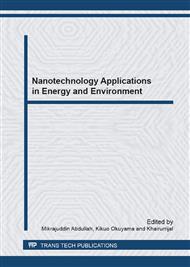p.28
p.33
p.37
p.43
p.54
p.60
p.67
p.74
p.80
Effect of Cold Rolling Treatment on the Formation of Titanium Oxide Layer on Ti6Al4V Alloys by Thermal-Electrochemical Anodizing Processes
Abstract:
The present work concerns on preparing suitable titanium alloy substrate that might induce better characteristic of titanium oxide layer on the substrate. Different degree of cold rolling treatments were applied on Ti6Al4V alloy before thermal-electrochemical anodizing processes. The later processes were performed to produce titanium oxide layer which combines thermal process by heat treatment and followed with electrochemical anodizing process. After thermal heat treatment process, it was observed more homogeneous titanium oxide layer for the samples given cold rolling treatment as compared with sample without the treatment. This condition is believed due to the finer substrate surface after cold rolling treatment as observed from surface roughness measurement. Similar situation was observed after anodizing process that irregular oxidized layer was observed for sample without cold rolling treatment, whereas more homogenous layer was observed for sample with cold rolling treatment. Except for sample without cold rolling treatment, anodizing treatment tends to create finer oxidized layer. Therefore, it can be concluded that cold rolling treatment on titanium substrate before oxidizing process induces the formation of homogeneous oxide layer, whereas additional anodizing process create finer titanium oxide layer.
Info:
Periodical:
Pages:
54-59
Citation:
Online since:
January 2013
Keywords:
Price:
Сopyright:
© 2013 Trans Tech Publications Ltd. All Rights Reserved
Share:
Citation:


